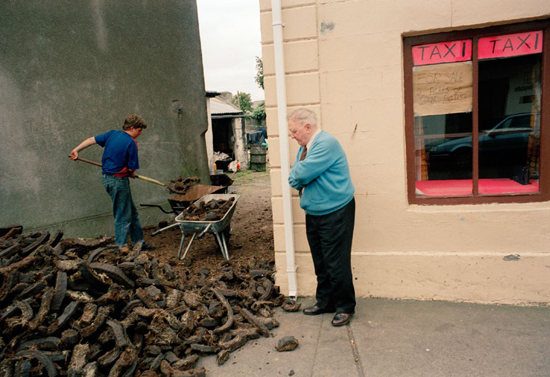TOM WOOD: LANDSCAPES
Oriel Mostyn, Llandudno
Tom Wood’s reputation is that of a street photographer, founded on work made in Merseyside from the 1970s to 2003 when he moved to North Wales. Subsequent books have continued to present his street work and portraiture, including Photie Man in 2005 – partly a synthesis of previously published work – followed by the two-volume set Men and Women produced last year. This year, however, Steidl is due to publish a three-volume collection, Landscapes, based on work made in Merseyside, North Wales and County Mayo where Wood was born, for which the present exhibition provides a taster.
The landscapes are presented as a twist in the Tom Wood story, a form of work that this ‘photographer of people’ has always carried out but not made public. Many photographs, however, clearly recall earlier series: pictures made through car windows which resemble Wood’s work made on Merseyside buses, ‘street photographs’ of people in rural settings, and urban landscapes, many containing people. There are also pictures made on the same day, at the same event, as others we already know. What does seem relatively new, although not unprecedented, are a series of panoramics made with a rotating film camera of rural scenes and building interiors. These have a more static character, owing partly to the nature of the equipment. They seem more detached and intended, less of a sudden offering thrown up by life. Seen alongside the more characteristic work, they produce an initial sense of disjuncture, as though we are looking at the work of two photographers. However, both the older and newer pictures share an approach to life and make a similar declaration of what photography can be, and what it might be for.
Wood’s street-type photographs unite elements of Winogrand and Eggleston in a British or Irish setting. At first glance his pictures may seem little or nothing, untidy snapshots without obvious drama or rhetoric; yet adjust to their register, and one sees that they contain that, and that, and that; self-contained collections of inter-related small marvels, often presented within a compelling arrangement of colour. An example from this show: Turf Taxi offers us, among other things, a heap of turfs on a pavement, a boy with a shovel filling a wheelbarrow, overseen by an older man next to a window with two pink signs reading ‘Taxi Taxi’, another sign offering ‘For sale, 2 acres of silage, Fotish’, and reflected in the window, a car. What starts as a play on words and forms of transport, takes in reflections on youth and age, town and country and the value of land. In Another Way of Telling John Berger likened a good photograph to a long quotation, long in terms of meaning, dense with suggestive possibilities; and he might have been describing almost any of Wood’s pictures, nearly all of which seem to suggest fullness, a concurrence and layering of multiple events, an edge-to-edge richness of life.
This same fullness is seen in the panoramics. Varied in subject matter, we have vistas across building sites, farmyards and woodland; close-ups of hedgerows and tree-roots; and interiors of barns, clothing shops and abandoned cottages, among much else. Each one is dense with small curiosities. The derelict homes greet us with generalised melancholy but their details quickly compel fascination. They radiate as much presence as absence; they are full of life. One interior, with yellow paint peeling off the walls and battered green door frames, offers us a collection of agricultural prize certificates pinned to walls both left and right, a fireplace with red-painted surround, with coat hanger above, a topless calendar jammed next to the kindling and a framed black-and-white portrait, perhaps of the former owner’s father or grandfather, askew to the right. The title: Idris, he lived happily.
Beyond this, the show resists easy generalisation. Images small and large, silverprints and inkjets, pinned to the wall and hung in frames, deliberate and snatched, coolly observational, anecdotal and comedic (Alan’s cow, with Charlie: tiny man on the cow’s head, big man on its rump!), with people and without, complexly suggestive and relatively simple (Back from Pontoon: a backlit running calf). Many push the customary definition of landscape beyond any comfortable limits. Even titles are inconsistent: some are neutral, others playful or prescriptive (Spoiled landscape), while many are still Awaiting title. The show has a provisional, unsettled quality.
Much of this makes sense, and even becomes a virtue, in light of Wood’s extraordinary way of working. Wood photographs, you might say, practically all the time. He has photographed five days a week throughout his career (his wife was the main breadwinner), and claims to have shot between three and ten rolls of film a day, as well as hours of video. Now with digital he makes 400–500 pictures a day, in addition to film. He photographs while bicycling. He photographs from the car, standing up through the sunroof while his wife drives. Wood’s photography, like Winogrand’s, is obsessive, prodigious. His archive must, conservatively, amount to at least a million photographs and still counting – quite a task for the researchers of the future. Even the current show spills over into a second location: a collection of workprints and out-takes is on display at Oriel Colwyn in nearby Colwyn Bay. No wonder the Steidl books are published as multi-volume sets. Wood, the quintessential photographer, seems uncontainable; everything is (or could be) interesting as a photograph, and his task is to photograph it all. The world doesn’t stop, it keeps growing; and Wood’s work demonstrates both the grandeur and impossibility of the photography project – it cannot ever be complete. The best one can say is: this is what I have got so far. Neatness and consistency would be a sign of failure. |
 |